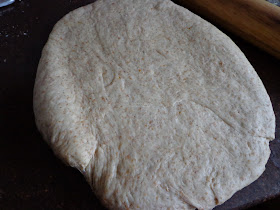Home made Bread
Bread is probably
a staple in most houses. As common as it may be in everybody’s grocery list, it
is a bit of a shame that a number of additives actually go into stor brought
bread. Ofcourse, same may not be the case if you buy it fresh from a bakery but
as it usually has a shelf life, atleast on the label of only one day or so, I
end up buying branded factory bread. It was a doctor friend of ours, a pediatrician who suggested that I start making bread and motivated me saying
if I can whip up over 300 dishes on my blog, bread must be easy. When the
doctor says I should rather make our own bread to avoid the additives for the
benefit of the kids, there can’t be any appeal right. So I started looking up
recipes and came across one on this website.
It is only by gut
feel that I chose the recipe suggested in that website. Also, the fact that it
does not need much kneading made it even more attractive. Anyway, when I tried
the recipe, it did come out quite well but I was not quite pleased with the
crust. When it comes to baking, practice alone can make one perfect so I tried
a few more times. Every time there was something to learn. I altered the oven
temperature so the crust is actually better. I will strongly recommend that you
try the recipe atleast twice or thrice so you know how much water works for you
and also what oven temperature works for your oven. Resist cutting into the
loaf soon after taking from the oven, the aroma will be difficult to control
yourselves though. Anyway, here is the recipe
400g strong wholemeal flour
50g strong white flour
2 tsp easy fast action yeast
2 tsp salt
3 tsp brown sugar
400ml warm water
50g melted butter or oil
50g strong white flour
2 tsp easy fast action yeast
2 tsp salt
3 tsp brown sugar
400ml warm water
50g melted butter or oil
Put together the flours, yeast, salt and sugar in a mixing bowl and mix well. Add about 300 ml water. The water should be hand warm. Stir well and add the butter. Mix to form a sticky and soft dough adding more water if needed. Make sure the dough is indeed sticky, you may feel it is not quite right but that is ok. You could do this in a food mixer with dough hook. I have done by hand as well as with mixer. The photos do not quite show how sticky the dough is, will change them to better pics when I get to it.
Tip out on to a lightly oiled work surface
and knead for about 10 seconds, then put back in the bowl and cover. This
kneading will help make it less sticky and more smooth. While kneading the
dough, I tried to do what Paul Hollywood showed on a TV show. You are suppose to
stretch the dough pressing it with your wrist and pulling it, then fold back. Repeat
twice more at intervals of 10 minutes, then leave the dough to rest for 15
minutes, until it doubles.
Flatten the dough into a rough rectangle
about the length of your baking tin, then roll up tightly, and put into a
greased tin, with the join facing downwards. If your dough has adequate water,
you should not need a rolling pin to flatten, just hand is enough. Cover and
leave to rest in a warm place until it has doubled in height (at least 1½
hours). I left it near the stove as I was cooking and the warmth will help the
yeast.
Pre-heat the oven to 190C. Bake for about
30 minutes. You know the bread is done when you tap it in the bottom (out of
the loaf tin ofcourse) and it sounds hollow. Cool completely on a cooling rack,
slice and store in air tight container. I prefer to store them in fridge and
warm them before eating.









Such a beautiful bread, wonderful job..
ReplyDeletecan we use normal wheat flour instead of wholemeal flour?
ReplyDeletehello, the flour i used is wholemeal bread flour and typically, bread flour has higher gluten content. It is to enable the gluten formation that the kneading is needed. You could use regular wholewheat flour, I am guessing it is not miles behind bread flour in gluten content. You may want to knead it for a bit longer than I have mentioned. Pls let me know how you get on.
DeleteCan wholemeal self rising flour be used for this?
DeleteLS
Hi, I would not use self rising flour as I would expect the soda bicarb in the flour to react with the yeast and not quite result in what we would expect in a regular bread.
Delete